Dream Engineers in the future are trying to fix the past by sending back messages in the forms of Dreams of Tomorrow.
What Is Dreams of Tomorrow?
Dreams of Tomorrow is a tableau-building game from Weird Giraffe Games for 1 to 6 players, ages 8 and up, and takes about 45 minutes to play. It’s currently seeking funding on Kickstarter, with a pledge level of $22 (plus shipping) for a copy of the game, or $5 for the high quality print and play. I think the gameplay and theme are both suitable for kids 8 and up, though younger kids might have a little trouble manipulating the action cards.
New to Kickstarter? Check out our crowdfunding primer, and visit our Kickstarter curated page for more projects we love.
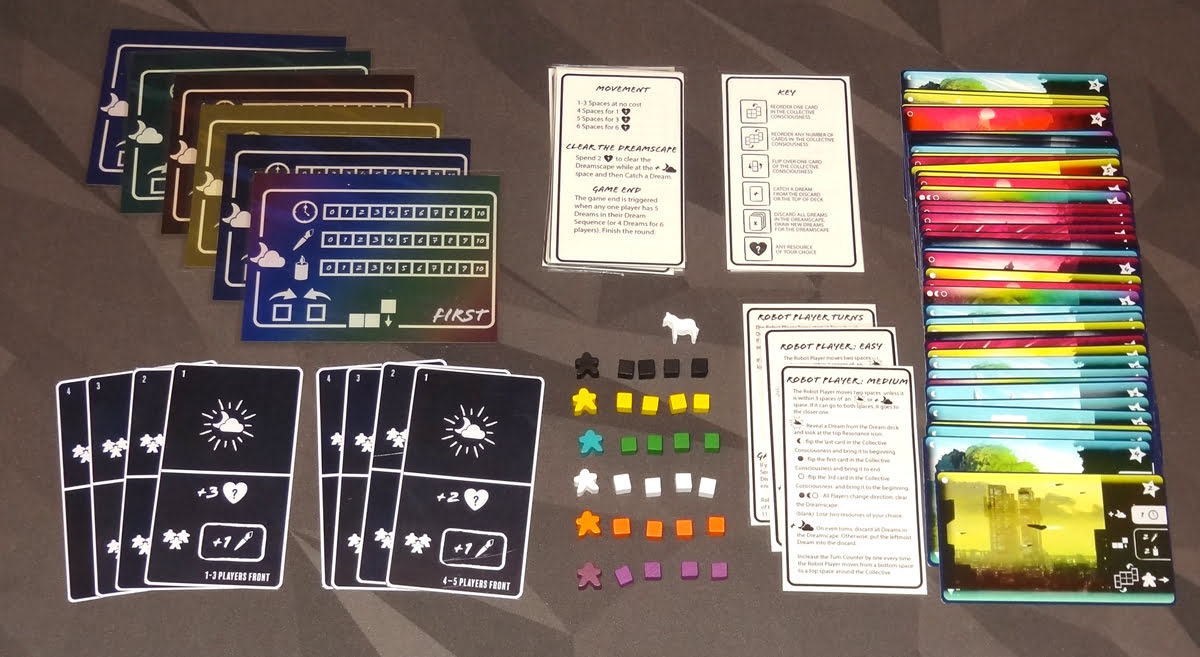
Dreams of Tomorrow Components
Note: My review is based on a prototype copy, so it is subject to change and may not reflect final component quality. The illustrations and graphic design of the cards is not final.
- 44 Dream cards
- 8 Consciousness Fragment cards
- 6 Player boards
- Night Mare Meeple
- 6 Meeples
- 24 Tracking cubes (4 per player color)
- 3 Robot Player cards
- 6 Reference cards
- 2 Icon Key cards

The dream cards and the consciousness fragment cards are all tarot-sized cards. On the dream cards, that means the vivid illustrations by James Masino can really shine, while still preserving room on the sides of the cards for gameplay information. The consciousness fragment cards make up the action spaces, and there’s room for the action icon plus the small meeples.
There are four copies of each scene, with values from 2 to 5 points; currently there are only minor differences between the copies, but I’m told that the scenes will have a little more variation among the copies.

The player boards are pretty simple (graphic design isn’t final) but they track your three resources—experience, creativity, and hope—as well as the direction your meeple moves. The left side is for your dream catcher, and the bottom side is for your dream sequence.
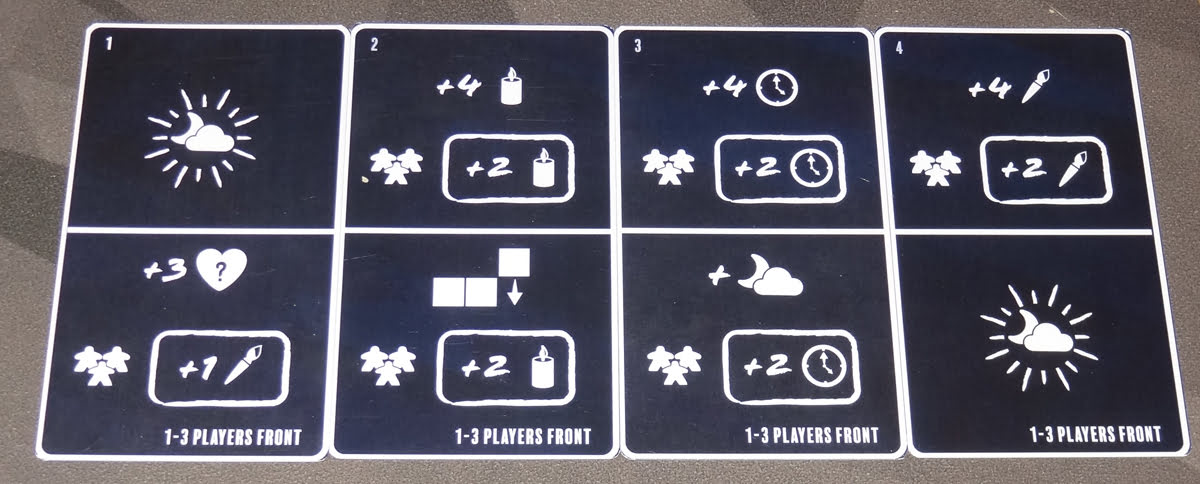
The consciousness fragment cards make up a grid of eight action spaces in a rondel—players will move clockwise or counterclockwise around these spaces, but actions can manipulate the cards, changing their positions or flipping them over (which swaps the positions of the two actions on a card). There’s a set of four cards for 1–3 players, and a set of four cards for 4–6 players.
How to Play Dreams of Tomorrow
You can check out the rules and the print and play files in case you want to give it a shot before deciding whether to back the project.
The Goal
The goal of the game is to score the most points by weaving together your dream sequence.

Setup
Place the consciousness fragment cards (based on the number of players) in the center of the table, arranged so that they’re in numerical order with the “front” side face-up: this is called the collective consciousness. Shuffle the dream cards and place a number (based on the player count) face-up to form a dreamscape, with the deck to the side.
Give everyone a player board and tokens of their chosen color. Place the meeples on the top space of the first card. Each player starts with 6 experience, 0 creativity, and 0 hope, and starts in the clockwise direction. The player who woke up earliest is the first player.
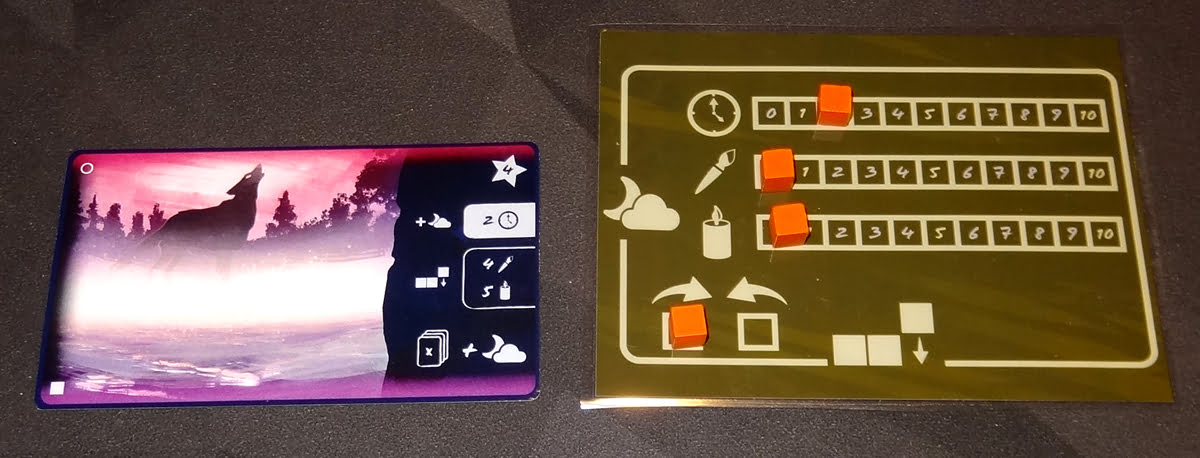
Starting with the first player, each player drafts a dream from the dreamscape, replacing dreams as they are taken. Each player must pay the experience cost (near the top right) of the dream they take. (If it’s your first game, you can just deal each player a dream.) This dream placed in your dream catcher, to the left of your player board.
Gameplay
On your turn, you move in the collective unconsciousness, and then take the action. You must move at least one space in the direction shown on your player board. Moving up to 3 spaces is free, but you may move up to 6 spaces by spending resources of your choice.

Then you take the action of the space where you land. Some spaces let you gain resources, one space lets you catch a dream, one space lets you claim a dream, and two spaces let you activate a dream. All of the spaces except the dream activation space have shared effects, letting all the other players gain resources of a specific type.
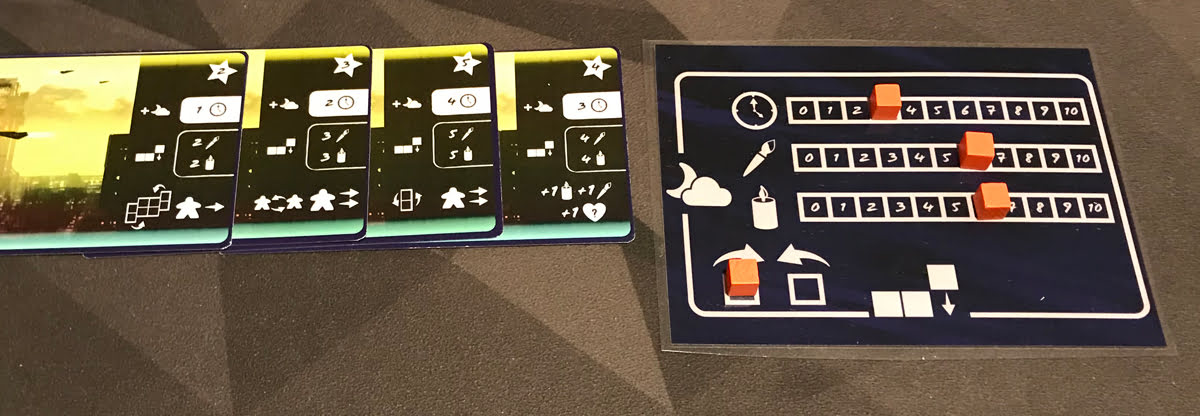
When you catch a dream, you spend the experience points shown on a dream in the dreamscape, and then place it into your dream catcher. Then replace the dream from the deck. You may spend 2 resources to discard the entire dreamscape and refill it as many times as you can afford to before catching a dream.
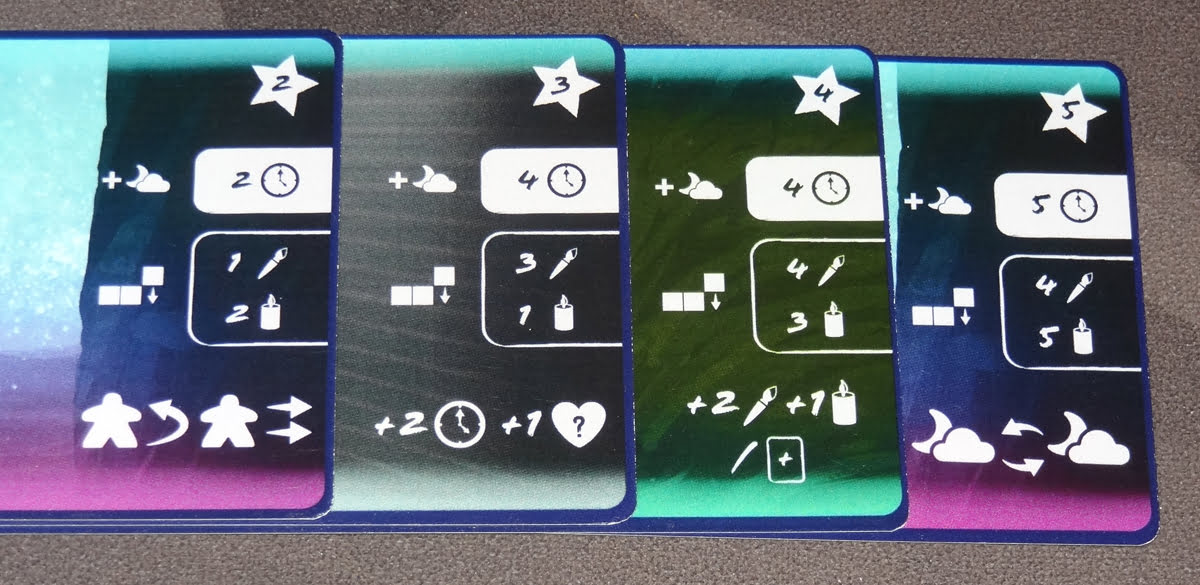
To weave a dream from your dream catcher into your dream sequence (below your player board), you spend the combination of hope and creativity shown on the dream card, and then add it to the right of any cards in your dream sequence, overlapping the cards to cover up the info portion of the previous dream.

At the bottom right of each dream card is a special ability. When you land on a dream activation space, you may activate one dream, either from your dream catcher or the most recent dream in your dream sequence. These abilities may let you claim resources, catch dreams from the discard pile, or move dreams around in your player area. There are also several abilities that let you move your meeple, often after manipulating the collective consciousness somehow—for instance, moving cards around, flipping them over, swapping places with other players, or changing your own player direction.
After you have moved your meeple and taken the associated action, your turn is over.
Game End
When any player completes their dream sequence of 5 dreams (or 4 dreams in a 6-player game), players finish the round so that all players have had the same number of turns, and then the game ends. (The game will also end if all dreams have been caught, though this is rare.)
You score points based on dreams in your dream sequence (not in your dream catcher). Each dream is worth the number of points at the top right of the card.

In addition, you score resonance points based on the colors and icons at the top and bottom of the dream cards in your sequence. The longer the sequence of matching symbols, the more points it’s worth. Some wild cards have three symbols on one edge, and none on the other.
The player with the highest score wins. Ties go to the player with the fewest dreams in their dream catcher, and then to the player with the most hope remaining.
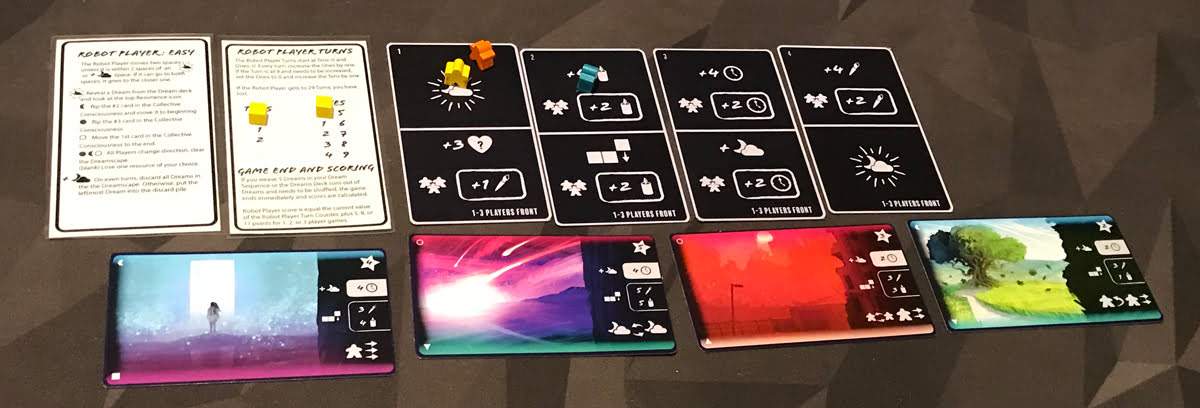
Game Variants: Robot Player and Troubled Night
There are a couple of variant modes that use the robot player card. First, with the robot player, you can add in an automated player with three difficulty levels, and it works with up to 3 players, including solo play. One card tracks the number of turns the robot has taken, and the other cards explain what the robot will do on its turn. For instance, in the easy mode, the robot will always move two spaces, unless it can reach a space to catch a dream or activate a dream. When it catches a dream, it will either discard one dream or clear the dreamscape (depending on the turn). When it activates a dream, it discards the top card of the dream deck, and has various effects depending on the resonance symbol on the card.
With the robot player, you have a limited number of turns to complete the game; if the deck runs out, the game also ends. The robot player’s turn is the number of turns it took plus 5, and you need to beat the robot’s score to win.
Troubled Night adds in the Night Mare, which will take its first turn after the last player. The Troubled Night uses one of the robot cards, but instead of moving around on the collective consciousness, it just discards the top card of the dream deck and activates the robot player ability based on the resonance icon; everything else from the robot player instructions is ignored. After every round, the Night Mare rotates counterclockwise.
If you’re a glutton for punishment, you can also combine these to have a robot player in Troubled Night mode.
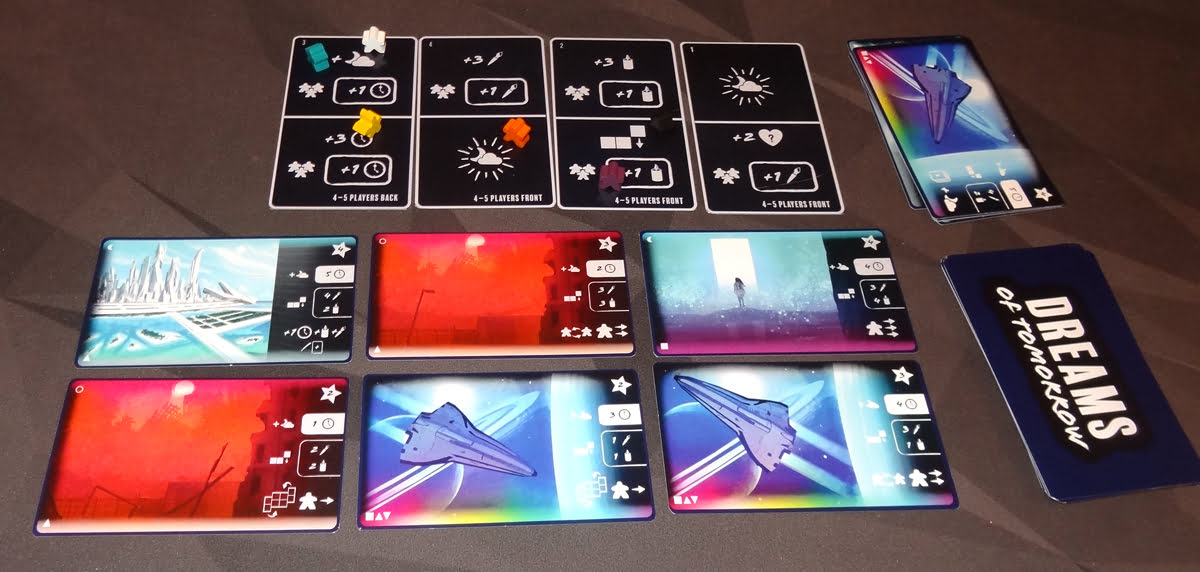
Why You Should Play Dreams of Tomorrow
Dreams of Tomorrow combines a cool sci-fi theme (cautionary messages from the future!) with some classic mechanics (set collection! card combinations!), and some twists that may be new to some players (modified rondel!), all in a small package.
Rondels aren’t a new idea: you move around in a circle, taking actions where you land, and the trick is often figuring out the timing so that you can get to the actions you want without wasted turns. I like the way that it’s implemented here, with the dream abilities that manipulate the rondel, moving cards around and flipping them over so that the order of actions is ever-changing. The downside is that once the game gets going, it can often be hard to plan your turn ahead of time, because who knows where you’ll be by the time it comes along. For that reason, this is a game that’s best for players who like to puzzle over a current game state to look for a short-term solution, rather than those who expect to have their turns mapped out ahead of time.
I also like the shared effects—as you gather resources, catch dreams, and weave dreams, you’re also giving everyone else resources. I suppose experienced players will be able to track more carefully what other players are trying to accumulate, but in most of my games so far we haven’t quite reached that level yet. We’re mostly just trying to figure out what we need ourselves, and if somebody gets a little boost here and there, so be it.
The actions in the collective consciousness are mostly simple enough: get resources, catch dreams, weave dreams. But activating dreams is where it really gets interesting. You can activate the right-most dream in your dream sequence, or any dream in your dream catcher, which opens up a lot of different approaches. For instance, you might use the “swap places, move 2” ability to get you to a needed space while also interfering with an opponent’s plans. Or you might use the “move to any space, pay 1 resource” to guarantee that you can always get to the spot you need. If you have the “swap 2 dreams” ability, you could weave a dream with a low cost, and then swap it out for one that you couldn’t afford. I’ve seen many turns where players were able to chain together multiple abilities to finally get them to the space they wanted to use.
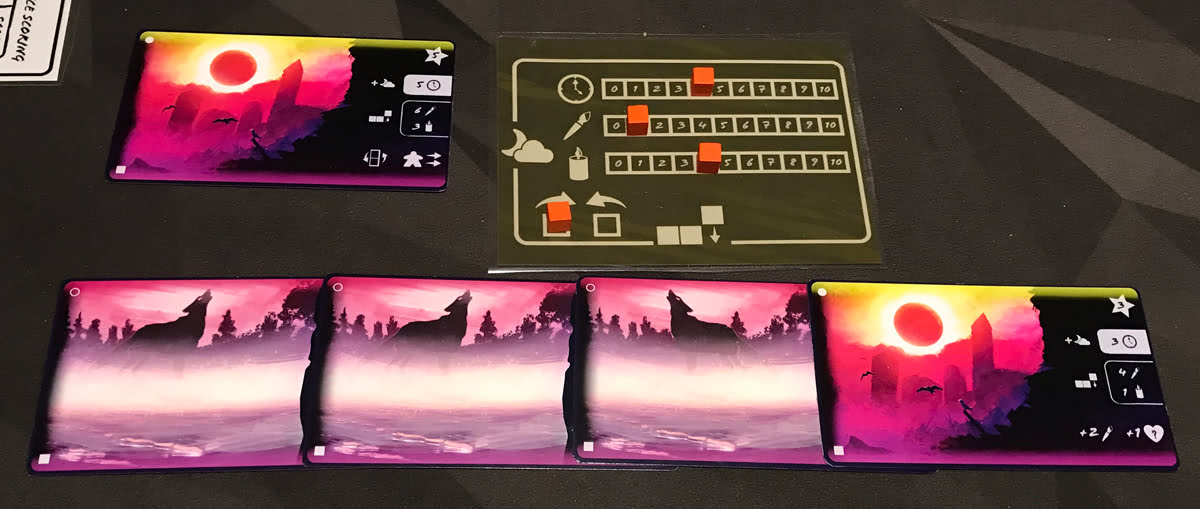
The scoring of the dreams themselves is a little more restrictive, because it feels to me like the best possible sequence is to collect the four dreams that share top and bottom resonance, plus one other that shares either the top or the bottom. What that means, though, is finding four copies of the same image—which makes for a high-scoring sequence but isn’t quite as interesting visually. (It’ll be at least a little more different than what you see above, since the differences will be a little more obvious.) Even though collecting such a sequence means the base values are 2-3-4-5, the resonance bonuses are usually high enough to beat a player who played a 5-5-5-5 sequence because they can’t get resonance across all four cards on top and bottom.
It can be possible, of course, to catch dreams that other players want, to prevent them from getting a collection, but it costs you resources and turns, and that same dream may not be as beneficial to you, either. It’s also possible to beat somebody by completing your dream sequence before they get their matching sequence woven together—just winning by quantity over quality—but that may depend on the luck of the draw, and how quickly a player is able to collect all four versions of a dream.
That means, at least for the current scoring values in the prototype, that it feels like the tactical decisions lie mostly in manipulating the rondel rather than deciding which dreams are the best to capture. That’s not a terrible thing by any means, because everyone in my gaming group really enjoyed that manipulation and the satisfaction of moving cards around to reach a previously unreachable space. But I do think that it could be even richer if it felt like there were more ways to build your sequence, rather than a race to the apparent optimal pattern.
The Night Mare and robot player options both introduce a little more chaos, wiping the dreamscape more often, which makes it harder to plan on collecting those four-of-a-kind sequences. If you like chaos, they both definitely keep you on your toes; if you want a little more control, the Pleasant Night default mode is a little better for that.
Overall, I enjoyed Dreams of Tomorrow at varying player counts. I like that it has that puzzle-solving feel to it, and I enjoy figuring out combinations of dream abilities to use to get to my goal. It’s fairly easy to learn the base game, but provides options to increase the challenge level when you’re ready.
For more information or to make a pledge, visit the Dreams of Tomorrow Kickstarter page!
Click here to see all our tabletop game reviews.
![]() To subscribe to GeekDad’s tabletop gaming coverage, please copy this link and add it to your RSS reader.
To subscribe to GeekDad’s tabletop gaming coverage, please copy this link and add it to your RSS reader.
Disclosure: GeekDad received a copy of this game for review purposes.






